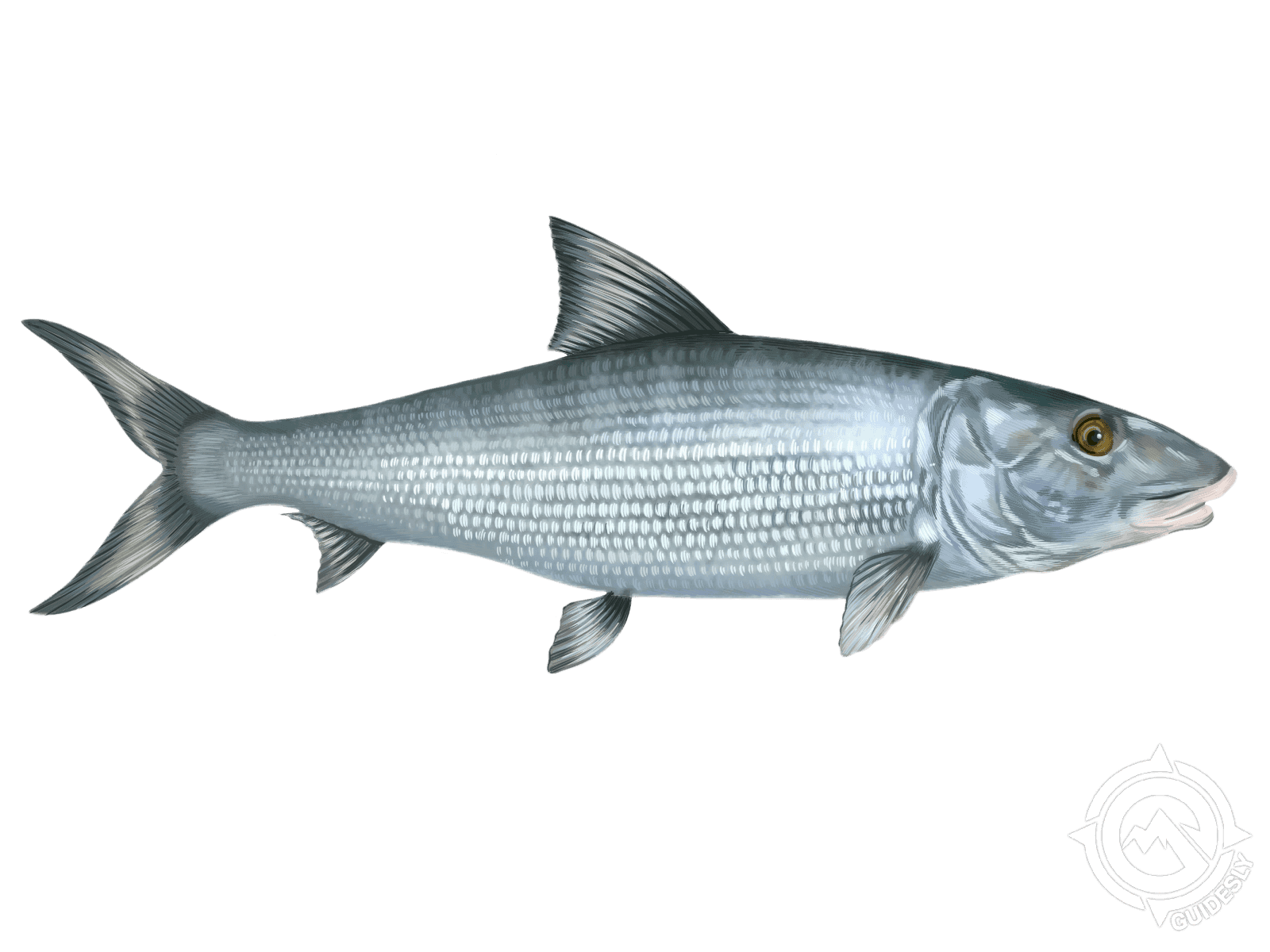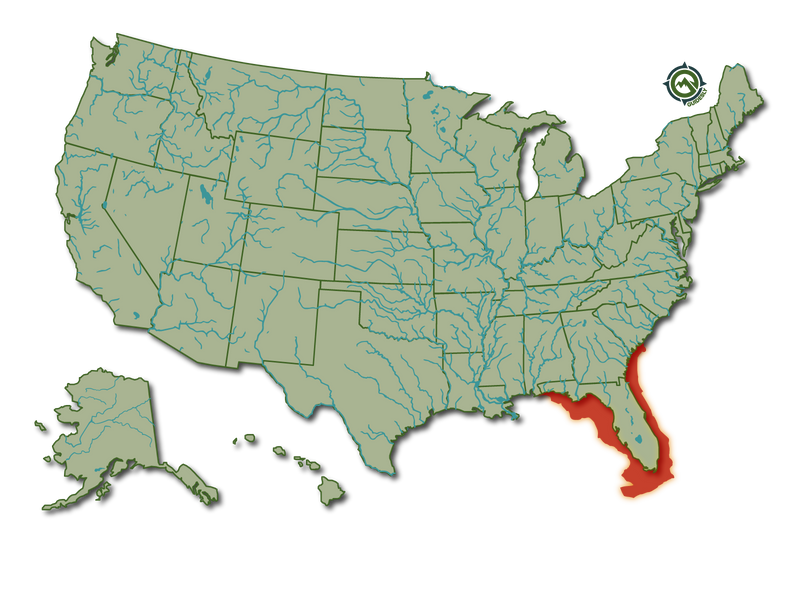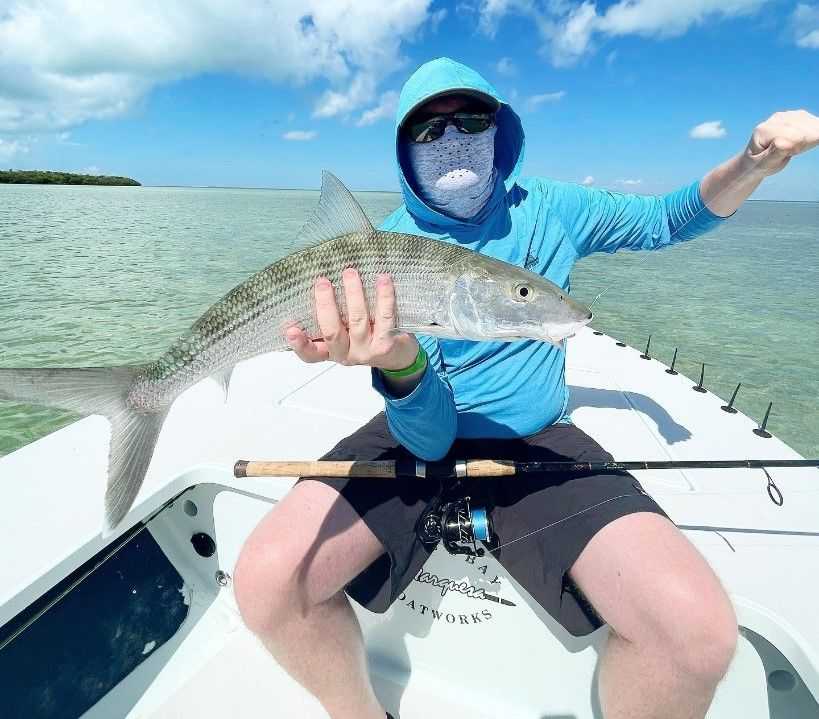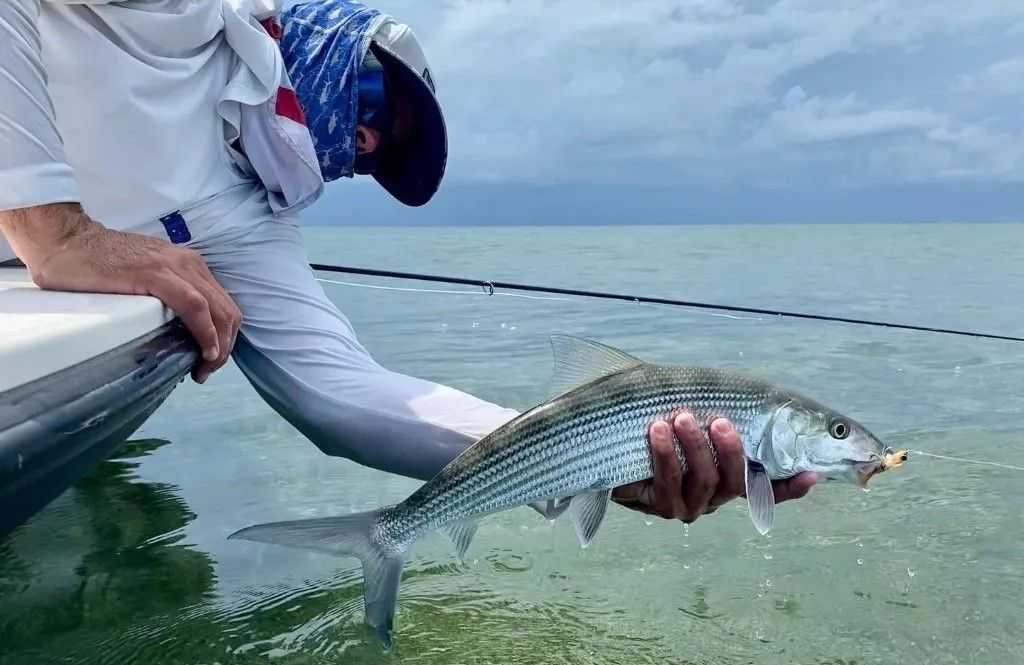Bonefish

Species Details
Albula Vulpes
Albulidae
Albuliformes
Onshore, Muddy Flats
4 - 16 lbs.
16" - 41"
Bonefishing: Description, Habitat, & Fishing Info | Guidesly
Learn everything you need to know about bonefish and bonefishing - from the best spots to get a bite, to the best tackle and bait options. Discover the best time and places to go bonefishing and a few of the key concepts.
Bonefish (Albula Vulpes)
Bonefish have an elongated, torpedo-shaped body with silvery scales. The dorsal fin (top) has a triangular shape similar to a shark's. The tail has a uniquely deep fork. Bonefish have blue-greenish backs with dark streaks that blend exceptionally well with the grass covering many flats' bottom. The sleek body and bottom have bright silvery scales that reflect the ocean bottom like a mirror. This natural camouflage allows the fish to remain largely undetected by anglers and their natural predators.
Bonefish are known for a couple of unique traits. First, bonefish tail in the water while feeding in shallow water, commonly called tailing. Second, they will take a fly/lure 100 yards or more once hooked in a dramatic run.
- Nicknames: Silver Ghost, white fox, Maccabi.
- Food value: Seldom eaten in Florida, too bony.
Distribution & Habitat
Bonefish live throughout portions of the Atlantic Ocean, Gulf of Mexico, Pacific Ocean, and the Caribbean Sea. Its range extends from Florida Keys, Biscayne Bay, Bahamas, Caribbean, Cuba, and Florida coasts.

During different times of day, bonefish occupy different types of habitats. When not hunting for food, bonefish live in deeper waters, down to about 300 ft. As the tide comes in, the fish swim into the shallow mudflats to search for food. You can find them in water as shallow as 4 inches deep.
Bonefish Size & Weight
Adult bonefish typically measure between 16 - 40 inches. Most weigh 6 - 8 pounds on average, but some reach 16 pounds. As adults, females grow larger than males and live up to 20 years.
Interesting Facts

- Speed – Bonefish are strong and fast, reaching speeds of 30 mph and quickly reaching top speed. When spooked, the grey ghost will travel 100 yards before you finish your cast.
- Unique Snout - Bonefish has a distinctive snout. The bonefish's inferior mouth and conical nose extend a third of its length beyond the mandible and are used to dig through the seabed to root up its prey. Bonefish have granular teeth, forming specialized dental plates cover the upper jaw, tongue, and throat. Bonefish use these modified teeth to grind mollusks and crustaceans.
- Breathing - Bonefish can survive in extremely shallow waters (flats) and brackish backwaters due to their modified air bladder that allows them to suck in air and process oxygen along with the oxygen in the water. This is especially important in shallow flats, mangroves, and backcountry waters, allowing bones to migrate from flats to deep waters with the tides.
- Migration – When you picture a migration, you might imagine a sea turtle crossing the ocean. Bonefish make short daily migrations, following the tide from coastal waters to the shallow mudflats to hunt for food.
Is Bonefish Good to Eat?
Many anglers target this elusive fish for sport, but some may wonder if it's good to eat. The answer is yes, bonefish can be eaten, but there are a few things you should know before you cook one up.
Firstly, bonefish are known for their strong flavor and meaty texture. They have a slightly sweet taste with hints of nutty flavors. However, they are also known for having many small bones that can be difficult to remove and make any fillet challenging to eat. To make the most out of your bonefish meal, it's recommended to fillet and debone the fish carefully. Additionally, it's important to note that bonefish can carry the ciguatera toxin commonly found in reef fishes. This toxin can cause food poisoning symptoms such as vomiting and diarrhea.
Bonefishing
Bonefishing is a sport that has been gaining popularity in recent years, and for a good reason. People enjoy fishing for bonefish so much that they have named the sport Bonefishing! Bonefishing is done by stalking the fish, either by wading or poling a shallow draft boat (skiff) and sight-casting at schools or individual fish spotted cruising or tailing in skinny water. Bonefish are known for their speed and agility. Bonefishing can be done both onshore and offshore, with many anglers choosing to wade through shallow waters to catch these elusive fish.
One of the reasons that bonefishing has become so popular is the challenge that it presents. Bonefish are notoriously difficult to catch due to their keen senses and fast swimming speeds. It takes skill and patience to reel in one of these fish successfully. Another reason why bonefishing is so attractive to anglers is the locations where it can be done. Many popular bonefishing spots are in beautiful tropical locations such as the Bahamas, Florida Keys, Belize, and Hawaii. These destinations offer excellent fishing opportunities, stunning scenery, and warm weather.
A couple of Great Bonefishing Articles:
Fishing Techniques - How to Catch a Bonefish
Bonefish spook easily. Anglers need a stealthy approach and accurate casts delivered just far enough ahead to keep from spooking an incoming school or individual bonefish. When fishing for mudding fish in water waist-high or deeper, natural or artificial offerings must be cast on the mud's outskirts and worked very slowly across it so you don't alarm the feeding fish.
What is Tailing
Tailing is one of those exciting events that should be on top of every angler's bucket list. Tailing occurs when a single or group of bonefish are in shallow water, usually, the flats, digging the ocean bottom for food. They use their tails for leverage to explore and search the bottom for crustaceans, their tails slapping the water for power and balance.
How to Approach Tailing Bonefish
When fishing for tailing Bonefish, sight fishing for the specific fish will provide more success. Be careful to cast to the middle of a large school that will spook easily. If you see a large group tailing, assume more fish are around the edges. Try and track the direction and speed of those fish.
On approach, start placing your fly, live bait, or jig on the edges targeting specific fish. The cast needs to be delicate and precise. If you question your skill at that distance, give a few feet not to spook the fish. Work patterns from the outer edges in, from side to side, and always sight-target a specific fish—the more precise the approach, the more likely the catch.
The Tides
There is some variation in tidal impact, but typically Bonefish are feeding/tailing around low tides. You can also find them at high tides, but they will be around the edges where it is more shallow. These fish feed across the current and move fast in alternating patterns.
Bonefishing Techniques
Bonefishing techniques range from fly fishing to light tackle and everything in between. Baits, like live shrimp and small crabs, or cut conch (in the Bahamas) are popular choices. A variety of lures, from skimmer jigs to small soft-plastic shrimp and crab imitations, ranging in weight from 1/16- to ¼-ounce, also work well.
Top 8 Fly Fishing Flies
The top 8 flies include the Gotcha (shrimp pattern), Crazy Charlie (shrimp), Peterson's Spawning Shrimp, Bonefish Slider Fly, Mantis Shrimp, Pillow Talk, Christmas Island Special, and any Crab patterns.
There's a wide range of proven flies, from old standards like the Clouser Minnow and Crazy Charlie to innovative patterns like the Borski Bonefish Slider, Dorsey Kwan, and many more.
Diet & Feeding Habits
Bonefish are carnivores. They hunt primarily in the shallow mudflats, feeding on crabs, shrimp, small fish, and various invertebrates like worms and snails. When hunting, they break off independently, in pairs, or small groups to search for prey.








